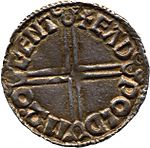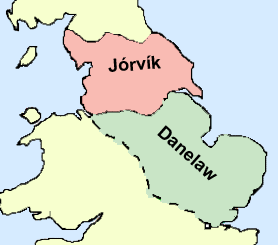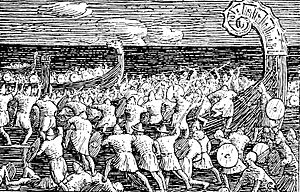Thored facts for kids
Quick facts for kids Thored |
|
|---|---|
| Ealdorman of York | |
| Reign | c. 964/974x979–992x994 |
| Predecessor | Oslac (?) |
| Successor | Ælfhelm |
| Born | c. 938 unknown |
| Died | 992 or 994 |
| Burial | unknown |
| Issue | Ælfgifu (died 1002) Æthelstan (died 1010) |
| Father | Gunnar (probable)/ Oslac (potential) |
| Mother | unknown |
Thored (pronounced THOR-ed) was an important leader in England way back in the 900s. He was an Ealdorman (a powerful local ruler) in York, controlling the southern part of Northumbria for the English king. He was likely the son of another important leader named Gunnar or possibly Oslac. We don't know much about his early life. Some records suggest he might have raided Westmorland in the 960s. But we are sure he became an ealdorman around 979.
Historians aren't sure about his connection to earlier kings like Edgar and Edward. However, it's believed he had a good relationship with King Æthelred II. Thored's daughter, Ælfgifu, even married King Æthelred. Thored served as ealdorman in Northumbria for many years. He disappears from historical records after 992, when King Æthelred sent him to lead a fight against the Vikings.
Who Was Thored?
Thored probably had some Scandinavian family background. This is suggested by the title used for him in an old book called the Anglo-Saxon Chronicle. In a record from 992, the leader of Hampshire is called an "ealdorman" (an English title). But Thored is called an eorl (a Scandinavian word, like "Earl").
Historians have two main ideas about who Thored's father was:
- Some think he was the son of Oslac, who was also an ealdorman of York from 966 until he was sent away in 975. This idea comes from an old book called Historia Eliensis, which says Oslac had a son named Thorth (another way to spell Thored).
- Most historians believe he was the son of a man named Gunnar. This Gunnar owned land in parts of Yorkshire.
If Gunnar was his father, then Thored might first appear in history in 966. The Anglo-Saxon Chronicle mentions: "In this year, Thored, Gunnar's son, raided Westmoringa land [Westmorland], and, in this same year, Oslac became ealdorman." Some historians think this raid was a local fight, not something King Edgar the Peaceable ordered. Gunnar might have been an ealdorman earlier, as he is mentioned in some old land documents from 963 and 965.
Thored might also be the person named Thored who signed royal documents during King Edgar's rule (959–975). His earliest possible signature is from 964. However, it's hard to be sure because some of these old documents might not be real.
Thored as Ealdorman
  |
|
| Front side: King Æthelred II's head. +ÆĐELRED REX ANGLOR (Æthelred King of the English) | Back side: A long cross. +EADǷOLD MO CÆNT (Eadwold the moneyer of Canterbury) |
| A silver penny from King Æthelred II's time (around 997–1003). The cross made it easier to cut the coin into smaller pieces. | |
We can be sure Thored was an ealdorman starting in 979. He signed many royal documents during the reign of King Æthelred II. He signed one in 979, six in 983, one in 984, three in 985, and one in 988. His last known signature was in 989. It's possible there was more than one person named Thored, but most historians don't think so. Thored's predecessor, Oslac, was sent away from England in 975. One historian thinks Oslac lost his position because he didn't support Edward the Martyr becoming king.
We know that Thored didn't get along well with Oswald, who was the Archbishop of York (a very important church leader) from 971 to 992. Oswald wrote that some church lands were lost when Thored came to power. One of these lost lands was Newbald. King Edgar had given Newbald to Gunnar. This makes some historians think Thored might have just been taking back land that he believed belonged to his family.
Thored's relationship with King Edgar is not clear. This is especially true because we don't know for sure who Thored's father was. Also, Oslac was banished in 975, the same year Edgar died. One historian, Richard Fletcher, thought Thored's raid on Westmorland happened because he was upset about Oslac becoming ealdorman instead of him. Fletcher believed Edgar then took away some of Thored's lands as punishment.
Thored's relationship with King Æthelred II seems to have been good. Ælfgifu, King Æthelred II's first wife, was probably Thored's daughter. An old book from the 1150s says that Æthelred II's wife was the daughter of an ealdorman named Thored. Historians think this marriage shows that Thored was a powerful local leader, and that Æthelred II married his daughter to gain Thored's support.
Thored's Last Days
We don't know the exact date Thored died. His last mention in history is in the Anglo-Saxon Chronicle for the year 992. This record talks about the death of Archbishop Oswald and a battle against a raiding Scandinavian fleet: "In this year the holy Archbishop Oswald passed away... Then the king and his advisors decided that all useful ships should gather at London. The king then put Ealdorman Ælfric (of Hampshire), Earl Thored, and Bishop Ælfstan and Bishop Æscwig in charge of the mission. They were to try to trap the Danish army at sea. But Ealdorman Ælfric secretly warned the enemy. Then, the night before the battle, he ran away from the army, which was a disgrace. The enemy escaped, except for the crew of one ship who were killed. Then the Danish army met the ships from East Anglia and London. They caused a great slaughter there and captured the ship, fully armed, that the ealdorman was on."
Scandinavian warriors, led by Óláfr Tryggvason, had been raiding England's coast since the year before. They had killed Ealdorman Brihtnoth of Essex at the Battle of Maldon.
Historians believe Thored either died fighting these Scandinavians or survived but lost his good name because of the defeat or betrayal. One historian, Fletcher, thought Thored was removed from his position and replaced by Ælfhelm because he failed against the Scandinavians. Another historian, William Kapelle, thought Thored was removed because he had Scandinavian family, which was seen as a problem after the battle.
A man named Æthelstan, who died in the Battle of Ringmere in 1010, was probably Thored's son. Thored's immediate successor as ealdorman was Ælfhelm, who started signing documents as ealdorman in 994.



